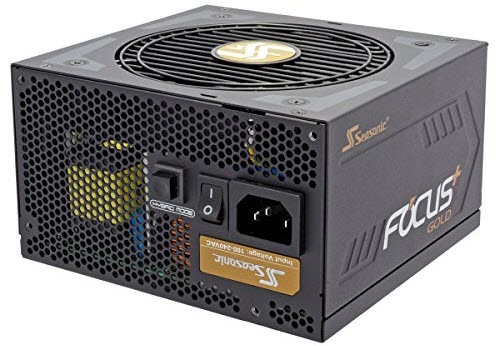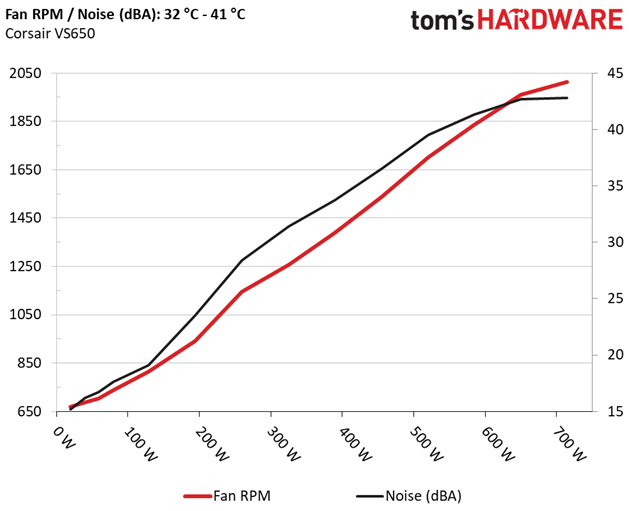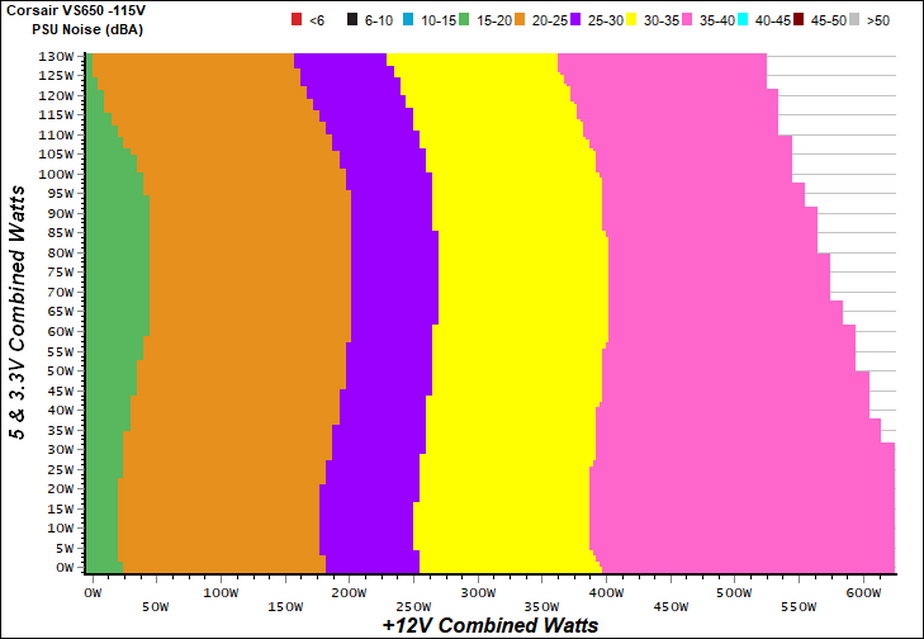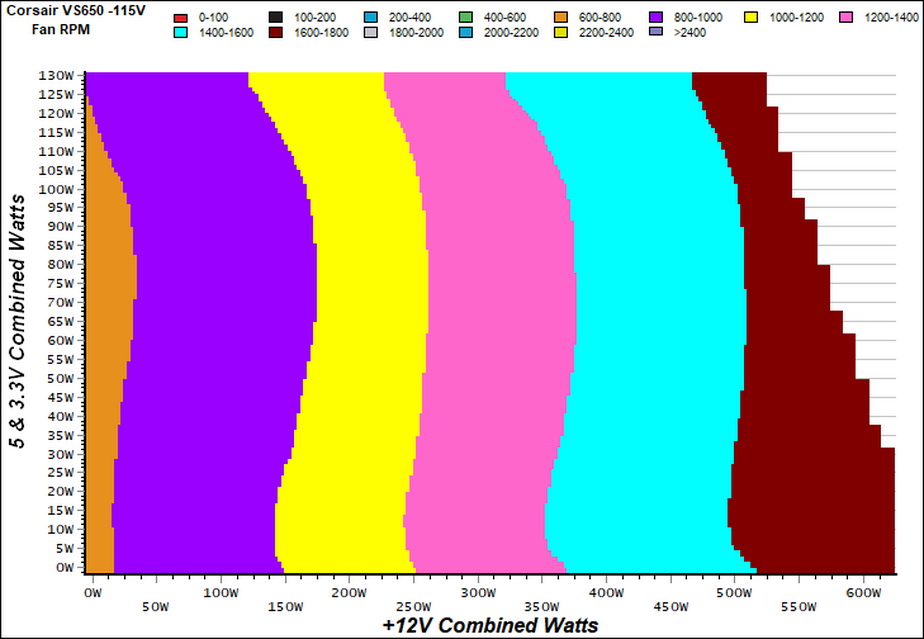Corsair VS650 Power Supply Review: Affordable Yet Capable
Why you can trust Tom's Hardware
Load Regulation, Hold-Up Time, Inrush Current, Efficiency and Noise
To learn more about our PSU tests and methodology, please check out How We Test Power Supply Units.
Primary Rails And 5VSB Load Regulation
The following charts show the main rails' voltage values recorded between a range of 40W up to the PSU's maximum specified load, along with the deviation (in percent). Tight regulation is an important consideration every time we review a power supply because it facilitates constant voltage levels despite varying loads. Tight load regulation, among other factors, improves the system’s stability, especially under overclocked conditions and, at the same time, it applies less stress to the DC-DC converters that many system components utilize.








The load regulation is nothing to write home about. We didn't expect for more in this section, given the outdated design of this platform.
Hold-Up Time
Put simply, hold-up time is the amount of time that the system can continue to run without shutting down or rebooting during a power interruption.




The hold-up time is lower than 16ms but the power-ok signal is accurate and this is important, because it doesn't provide fake information to the mainboard and the rest components, so it doesn't expose them to dangerously low voltage rails.
Inrush Current
Inrush current, or switch-on surge, refers to the maximum, instantaneous input current drawn by an electrical device when it is first turned on. A large enough inrush current can cause circuit breakers and fuses to trip. It can also damage switches, relays, and bridge rectifiers. As a result, the lower the inrush current of a PSU right as it is turned on, the better.


The pair of NTC thermistors does a good job, keeping the inrush currents at normal levels.
Get Tom's Hardware's best news and in-depth reviews, straight to your inbox.
10-110% Load Tests
These tests reveal the Corsair VS650’s load regulation and efficiency levels under high ambient temperatures. They also show how the fan speed profile behaves under increased operating temperatures.
| Test # | 12V | 5V | 3.3V | 5VSB | DC/AC (Watts) | Efficiency | Fan Speed (RPM) | PSU Noise (dB[A]) | Temps (In/Out) | PF/AC Volts |
|---|---|---|---|---|---|---|---|---|---|---|
| 1 | 3.533A | 1.977A | 1.948A | 0.999A | 64.781 | 80.131% | 739 | 17.6 | 34.89°C | 0.966 |
| 12.225V | 5.056V | 3.385V | 5.005V | 80.844 | 40.29°C | 115.09V | ||||
| 2 | 8.062A | 2.975A | 2.931A | 1.203A | 129.252 | 84.824% | 814 | 19.1 | 35.15°C | 0.975 |
| 12.201V | 5.042V | 3.373V | 4.988V | 152.377 | 41.69°C | 115.09V | ||||
| 3 | 13.020A | 3.472A | 3.419A | 1.409A | 194.380 | 86.012% | 943 | 23.5 | 36.10°C | 0.981 |
| 12.164V | 5.041V | 3.363V | 4.971V | 225.992 | 43.08°C | 115.09V | ||||
| 4 | 18.004A | 3.969A | 3.936A | 1.615A | 259.607 | 86.121% | 1145 | 28.4 | 37.55°C | 0.987 |
| 12.131V | 5.039V | 3.353V | 4.955V | 301.445 | 45.39°C | 115.09V | ||||
| 5 | 22.654A | 4.972A | 4.937A | 1.823A | 324.910 | 85.671% | 1256 | 31.4 | 37.86°C | 0.991 |
| 12.113V | 5.029V | 3.341V | 4.938V | 379.254 | 46.29°C | 115.09V | ||||
| 6 | 27.269A | 5.976A | 5.947A | 2.034A | 389.428 | 84.977% | 1389 | 33.7 | 38.00°C | 0.993 |
| 12.088V | 5.020V | 3.329V | 4.918V | 458.276 | 47.01°C | 115.09V | ||||
| 7 | 31.970A | 6.987A | 6.966A | 2.246A | 454.762 | 84.051% | 1537 | 36.5 | 38.45°C | 0.995 |
| 12.063V | 5.010V | 3.316V | 4.899V | 541.053 | 48.20°C | 115.09V | ||||
| 8 | 36.692A | 8.002A | 7.990A | 2.460A | 520.057 | 82.958% | 1700 | 39.5 | 39.83°C | 0.995 |
| 12.037V | 4.999V | 3.303V | 4.879V | 626.893 | 50.38°C | 115.09V | ||||
| 9 | 41.881A | 8.499A | 8.507A | 2.468A | 584.989 | 81.800% | 1836 | 41.3 | 39.98°C | 0.995 |
| 11.998V | 5.001V | 3.291V | 4.863V | 715.145 | 51.55°C | 115.10V | ||||
| 10 | 46.815A | 9.000A | 9.058A | 3.104A | 649.836 | 80.345% | 1960 | 42.7 | 40.93°C | 0.997 |
| 11.965V | 5.000V | 3.278V | 4.833V | 808.807 | 53.47°C | 115.10V | ||||
| 11 | 52.447A | 8.984A | 9.090A | 3.114A | 714.660 | 78.970% | 2014 | 42.8 | 41.38°C | 0.997 |
| 11.916V | 5.009V | 3.267V | 4.818V | 904.971 | 54.45°C | 115.10V | ||||
| CL1 | 0.144A | 16.000A | 15.997A | 0.000A | 126.874 | 76.526% | 1334 | 33.1 | 37.55°C | 0.976 |
| 12.692V | 4.481V | 3.335V | 4.959V | 165.792 | 46.54°C | 115.11V | ||||
| CL2 | 52.006A | 1.002A | 0.999A | 1.000A | 624.900 | 81.103% | 1868 | 42.5 | 41.10°C | 0.996 |
| 11.757V | 5.234V | 3.309V | 4.916V | 770.501 | 53.28°C | 115.11V |
We chose not to go close to 45°C, as we usually do, since the VS650 is only rated up to 30°C. Nonetheless, even with 41.4°C it survived test #11 with 110% of its max-rated-output load. This shows that Corsair used parts that can take some abuse without complaining (or exploding).
The fan profile gets aggressive once the ambient temperature climbs, but this is natural since this unit's efficiency is low so the thermal loads at its internals are high. The good thing is though that under light loads the fan spins at low speeds, keeping the noise equally low.
20-80W Load Tests
In the following tests, we measure the Corsair VS650's efficiency at loads significantly lower than 10 percent of its maximum capacity (the lowest load the 80 PLUS standard measures). This is important for representing when a PC is idle, with power-saving features turned on.
| Test # | 12V | 5V | 3.3V | 5VSB | DC/AC (Watts) | Efficiency | Fan Speed (RPM) | PSU Noise (dB[A]) | PF/AC Volts |
|---|---|---|---|---|---|---|---|---|---|
| 1 | 1.174A | 0.491A | 0.469A | 0.199A | 19.444 | 66.055% | 669 | 15.2 | 0.924 |
| 12.223V | 5.090V | 3.396V | 5.035V | 29.436 | 115.09V | ||||
| 2 | 2.418A | 0.984A | 0.970A | 0.398A | 39.825 | 75.420% | 689 | 16.2 | 0.947 |
| 12.215V | 5.080V | 3.392V | 5.026V | 52.804 | 115.09V | ||||
| 3 | 3.597A | 1.478A | 1.445A | 0.598A | 59.328 | 79.866% | 703 | 16.7 | 0.960 |
| 12.216V | 5.069V | 3.388V | 5.017V | 74.284 | 115.09V | ||||
| 4 | 4.846A | 1.976A | 1.949A | 0.799A | 79.781 | 82.170% | 728 | 16.9 | 0.965 |
| 12.214V | 5.059V | 3.383V | 5.007V | 97.093 | 115.09V |
Under light loads the efficiency levels are satisfying, for a vanilla 80 PLUS and ETA-S certified unit, while the fan spins at very low speeds with the noise output staying within 15-17 dB(A).
Efficiency
Next, we plotted a chart showing the Corsair VS650’s efficiency at low loads, and loads from 10 to 110 percent of its maximum-rated capacity. The higher a PSU’s efficiency the less energy goes wasted leading to a reduced carbon footprint, besides lower electricity bills.




With normal loads the unit scores last, but with light loads, it manages to take the lead from the EVGA 650 BQ. Definitely not impressive performance, but you should keep in mind that it is the most affordable of all.
5VSB Efficiency
| Test # | 5VSB | DC/AC (Watts) | Efficiency | PF/AC Volts |
|---|---|---|---|---|
| 1 | 0.100A | 0.504 | 78.019% | 0.056 |
| 5.043V | 0.646 | 115.07V | ||
| 2 | 0.250A | 1.260 | 80.306% | 0.166 |
| 5.040V | 1.569 | 115.07V | ||
| 3 | 0.550A | 2.769 | 80.658% | 0.281 |
| 5.034V | 3.433 | 115.07V | ||
| 4 | 1.000A | 5.025 | 80.866% | 0.363 |
| 5.024V | 6.214 | 115.07V | ||
| 5 | 1.500A | 7.521 | 80.490% | 0.408 |
| 5.014V | 9.344 | 115.07V | ||
| 6 | 3.000A | 14.947 | 76.691% | 0.471 |
| 4.983V | 19.490 | 115.07V |
The 5VSB rail achieves high efficiency levels. This is a nice surprise!

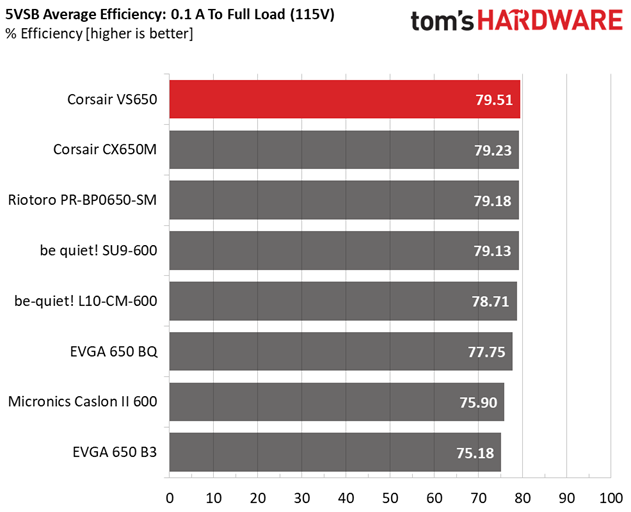
Power Consumption In Idle and Standby
| Mode | 12V | 5V | 3.3V | 5VSB | Watts | PF/AC Volts |
|---|---|---|---|---|---|---|
| Idle | 12.223V | 5.108V | 3.400V | 5.045V | 6.652 | 0.607 |
| 115.1V | ||||||
| Standby | 0.043 | 0.005 | ||||
| 115.1V |

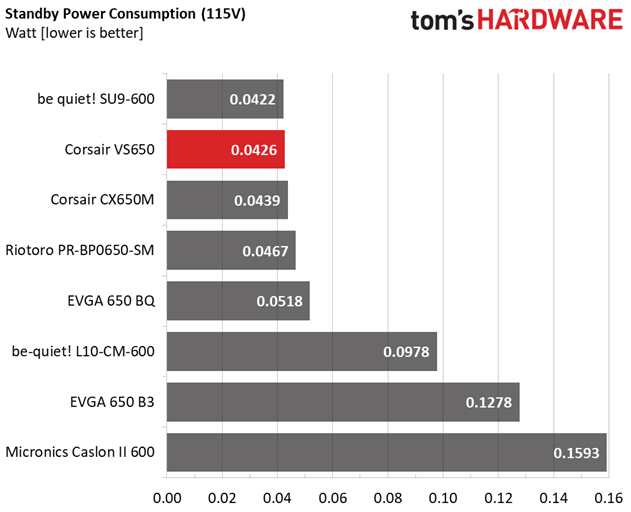
Fan RPM, Delta Temperature, and Output Noise
All results are obtained between an ambient temperature of 32°C (89.6°F) to 41°C (105.8°F).
The fan's noise is kept low under lighter loads (<280W) even under high operating temperatures. With higher loads naturally the fan control circuit has to increase the airflow to remove the heat out of the PSU's internals. If the platform's efficiency was higher, the thermal loads would be lower, so the fan wouldn't have to spin at high speeds.
The following results were obtained at 30°C (86°F) to 32°C (89.6°F) ambient temperature.
Under normal operating temperatures the PSU exceeds the 35 dB(A) threshold so, it gets noisy, with any load combination exceeding 400W. The good thing is that even in the worst case scenario we don't get any readings above 40 dB(A), like we did under high operating temperatures.
MORE: Best Power Supplies
MORE: How We Test Power Supplies
MORE: All Power Supply Content
Current page: Load Regulation, Hold-Up Time, Inrush Current, Efficiency and Noise
Prev Page Specifications and Part Analysis Next Page Protection Features, DC Power Sequencing, Cross-Load Tests and Infrared Images
Aris Mpitziopoulos is a contributing editor at Tom's Hardware, covering PSUs.

